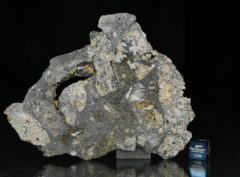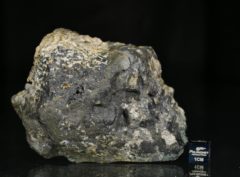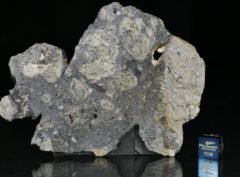Classification: Achondrite Howardite-melt breccia S-high / W-low
Place/Time: 2019 in Mali
Mass: 1344g
Classification: Howardite-melt breccia due to presence of eucritic and diogenetic material embedded in a melt rock matrix.
History: The meteorite was found by Muhhamad Imam in Mali and sebsequently purchased by Marcin Cimala.
Physical characteristics: Light to dark grayish rock with some larger cavities and few patches of fusion crust.
Petrography: The meteorite is an achondritic melt breccia consisting of large black-white speckled to completely black melt regions showing pronounced flow structures and whitish less intensely or entirely unmelted clasts. Melt regions are composed of exsolved pyroxene, recrystallized pyroxene displaying mottled compositional zoning, and calcic plagioclase fragments set into a recrystallized matrix of pyroxene and often fibrous feldspar. Vesicles are abundant in the matrix and the mineral fragments frequently show resorbtion features at their contact to the melt. Unmelted regions show an overall eucritic mineral assemblage with exsolved pyroxene and plagioclase fragments set into a clastic matrix. Minor phases are silica, chromite, FeS, and rare metallic iron. The meteorite contains large up to 4 mm sized diogenetic low-Ca pyroxenes some of which have olivine, augite, and/or feldspar inclusions. Due to the heterogeneity of the material it is not possible to determine the percentage of diogenetic material precisely, i.e., more or less than 10 vol.%. The unmelted precursor was, thus, either a polymict eucrite or a howardite.
Geochemistry: diogenetic pyroxene: Fs34.3±0.2Wo2.0±0.4 (Fs33.9-34.7Wo1.7-3.2, n=12, FeO/MnO=27-30); olivine: Fs49.0±0.5 (Fs48.4-49.7, n=11, FeO/MnO=46±1); eucritic low-Ca pyroxene: Fs59.8±0.3Wo1.8±0.1 (Fs59.2-60.2Wo1.7-1.9, n=11, FeO/MnO=28-32); eucritic Ca-pyroxene: Fs24.5±1.7Wo44.0±0.4 (Fs21.5-25.9Wo43.1-44.7, n=14, FeO/MnO=26-32); calcic plagioclase: An92.7±0.6 (An91.6-93.6, n=12)
NOTE: Slices was cut extremely thin and best prepared to show huge translucent plagioclases. Total cut lose was near 30%.







